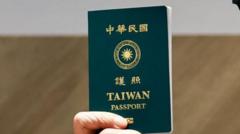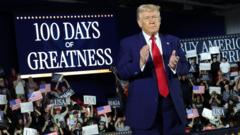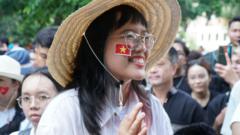Xi's administration grapples with economic disparities and youth discontent as trade tariffs exacerbate existing vulnerabilities.
**Xi Jinping Faces Internal Challenges Amid U.S. Trade Tensions**

**Xi Jinping Faces Internal Challenges Amid U.S. Trade Tensions**
The Chinese leader's economic vision is under pressure as domestic issues rise.
China's dynamics are shifting in the wake of U.S. trade tensions, particularly with Donald Trump's recent tariff measures that may not concern local traders as much as their domestic economic instability does. Chinese traders, instead of fearing Trump's proposed 145% tariffs, have turned to humor, creating memes about U.S. figures as they take pride in China's resilience. President Xi Jinping has reiterated that China's economic model relies on self-sufficiency and hard work rather than external aid.
Currently, however, China's domestic market is sluggish. While the country experienced considerable economic growth over the past decade, a current housing market collapse has made families hesitant to spend. Many invested in real estate that has lost value, leaving a disillusioned populace facing empty properties in sprawling ghost cities, leading to diminished consumer confidence. Compounding this issue are fears over the future of pensions for the country's aging population. Analysts have identified that nearly 300 million people will exit the workforce in the coming decade, and the pension fund may be empty by 2035.
Job prospects for the younger generation are dim as well, with youth unemployment rates soaring, particularly among urban graduates. The lack of immediate recovery in domestic spending places Xi's 13-year dream of prosperity in jeopardy. Experts agree that overcoming these internal challenges is crucial if China is to replace lost U.S. export opportunities with local demand, but progress will demand substantial time.
In a precarious situation, Xi is aware that the dissatisfaction of younger citizens could lead to unrest. Recent reports indicate a rise in protest activity linked to economic grievances, although these demonstrations are swiftly suppressed by the government. The pivot to advanced technologies has provided China with some resilience, but the threat from U.S. tariffs lingers.
In response to these trials, Xi’s administration is attempting to stimulate domestic demand with initiatives aimed at childcare support, wage increases, and consumer incentives. Yet, without innovative solutions for raising disposable income sustainably, long-term recovery seems elusive.
Globally, as trade tensions persist, Xi is strategically seeking to strengthen connections in Southeast Asia and other markets to offset the impact of reduced exports to the U.S. China has diversified its trade partnerships significantly, with more countries now trading more with it than with the U.S., indicating a shift in geopolitical dynamics.
Ultimately, while Trump’s tariffs pose immediate challenges, they may offer Xi a chance to recalibrate China's position on the world stage. The question remains whether China can address what lies within—finding new paths to growth and securing an enduring economic foundation in the face of external pressures.
Currently, however, China's domestic market is sluggish. While the country experienced considerable economic growth over the past decade, a current housing market collapse has made families hesitant to spend. Many invested in real estate that has lost value, leaving a disillusioned populace facing empty properties in sprawling ghost cities, leading to diminished consumer confidence. Compounding this issue are fears over the future of pensions for the country's aging population. Analysts have identified that nearly 300 million people will exit the workforce in the coming decade, and the pension fund may be empty by 2035.
Job prospects for the younger generation are dim as well, with youth unemployment rates soaring, particularly among urban graduates. The lack of immediate recovery in domestic spending places Xi's 13-year dream of prosperity in jeopardy. Experts agree that overcoming these internal challenges is crucial if China is to replace lost U.S. export opportunities with local demand, but progress will demand substantial time.
In a precarious situation, Xi is aware that the dissatisfaction of younger citizens could lead to unrest. Recent reports indicate a rise in protest activity linked to economic grievances, although these demonstrations are swiftly suppressed by the government. The pivot to advanced technologies has provided China with some resilience, but the threat from U.S. tariffs lingers.
In response to these trials, Xi’s administration is attempting to stimulate domestic demand with initiatives aimed at childcare support, wage increases, and consumer incentives. Yet, without innovative solutions for raising disposable income sustainably, long-term recovery seems elusive.
Globally, as trade tensions persist, Xi is strategically seeking to strengthen connections in Southeast Asia and other markets to offset the impact of reduced exports to the U.S. China has diversified its trade partnerships significantly, with more countries now trading more with it than with the U.S., indicating a shift in geopolitical dynamics.
Ultimately, while Trump’s tariffs pose immediate challenges, they may offer Xi a chance to recalibrate China's position on the world stage. The question remains whether China can address what lies within—finding new paths to growth and securing an enduring economic foundation in the face of external pressures.





















